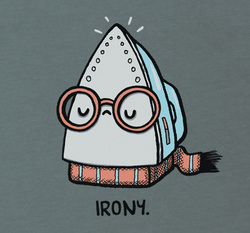
So apparently there is a GLPP Career Day coming up, and they want us (AP english students) to basically put it on. First thing I thought was...WHAT? We actually have one of these, and why are they just telling us now? However, it seemed like a good event and I'm pretty sure we all can be great hosts. I am a host for Ms. Danielle Arndt. Asia and I need to make a brochure, certificate, and thank you letter. Hopefully we get this done.

We went to room 100 to perform our irony skits in front of the class. Doing this activity was really fun and made you grasp the idea of all the types of irony. Our group basically incorporated the whole class because it was so intricate. It was about a huge obsession with "the king". The skit had a lot of dramatic or tragic irony. Everyone basically died except me :) "the princess". I think we should do more activities like this.

We just got back from break and everyone looks stuffed. I had a great Thanksgiving. Today we talked about irony, again. Everyone brought up their papers and examples of irony they found. I am pretty sure I jotted down some good examples, for instance; A person wants to lose weight and takes dietary pills to help them lose weight, but the pills end up making them gain weight. During class we also got another definition of irony which is: irony involves a difference or contrast between appearance and reality-that is a discrepancy between what appears to be true and what really is true. We learned another type of irony called cosmic irony and it is when it has to do with fate, God, Destiny controlling irony.

Today we talked about irony. Definition: a figure of speech in which the intended meaning and the actual meaning differ, characteristically using praise to indicate the blame or using blame to indicate praise; a pattern of words that turns away from direct statement of its own obvious meaning. There are different types of irony and they are; situational, verbal, dramatic, and tragic (which is a form of dramatic irony). I found two websites that told me valuable information about irony: The oatmeal.com and oxfordlearnersdictionary. You have to be careful though because most irony is NOT irony, it most likely is unfortunate.

Class Objectives:
(1) Define allegory.
(2) Explain each character's role in the allegory (create a character chart). In the context of the roles you explained, explain how this story is an allegory for the time period in which it was written.
Activities:
(#'s 1-3 from last week's lesson about this short story)
(4) Read "Where Are You Going, Where Have You Been" by Joyce Carol Oates (1966) pg. 311 in Perrine's Literature.
(5) What do the numbers on Arnold's car mean/symbolize? What about Arnold Friend's name? Take out the "r" in each name and you get: An old Fiend
(6) Consider the unusual dedication by Oates to Bob Dylan:
(7) Listen to "Its All Over Baby Blue" by Bob Dylan (1965) and read the lyrics:
(8) Who is Charles Schmid: the Pied Piper?
(9) Listen to "The Pied Piper" by Chrispian St. Peters (1966) and read the lyrics.
(10) Watch and excerpt of the 1988 movie Smooth Talk, starring Laura Dern.
(11) How is this story an allegory? What does each character represent? What does the name Connie mean?
This week we have to take the NWEA test. I do not care for that test. I actually do not like any type of proficiency tests like the Meap, ACT, etc. I feel that they are based off luck. You may not get the right answer that day but you still know the subject. We have to do the test two days in a row, wish me good luck.

Today we finished the movie Atonement. I was very confused on the movie until Mrs. Fassbender shed some light on it. I thought that Cecilia and Robert got together but it seemed as if it was only in Brianey's imagination. Her sister and her lover died but she felt that they deserved to be together. Briany wrote a book and ultimately put them together. We also learned about catharsis. Catharsis is Greek by Aristotle. The definition is having many emotions then letting them go.

Today we talked about symbol, allegory, and fantasy. This was all out of our big blue literature books. We got a lot of key terms out of this chapter.
-Compression: say as much as possible
-Consider every name is literary work
-It is easy to push symbolism too far
-Does the story lose any meaning
CAUTIONS!
1. Symbols always signal their existence by emphasis, repetition, or position.
2. The symbol has to be consistent throughout the whole story.
3. A symbol must be more than it's literal meaning
4. Symbols can have multiple symbolic meanings

Today is a half-day because of parent-teacher conferences. Ms. Fassbender was also absent today. Our class objectives were:
-Review the literary concept - Point of View
-Read a short story to determine how the point of view affects the characterization, symbolism, motif, and theme.
We read two stories called "The Jilting of Granny Weatherall" by Katherine Anne Porter and "Hills Like White Elephants" by Ernest Hemingway. Afterwards we came together as a group and described how point of view helped develop the theme of both stories in 1-3 sentences. This day was pretty easy and laid back.










 RSS Feed
RSS Feed